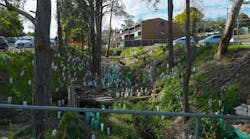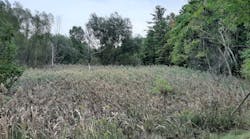Editor’s Comments: Valuable Resource or Noxious Weed?
If there’s one thing that stands out as a black eye in the history of erosion control, it’s the use of plants that turn out to be invasive. Many of them have root systems that are excellent at anchoring the soil; that’s the upside, and the reason we’ve so often imported them, sometimes from halfway around the world. The downside is that they eventually devastate the very environments we were trying to protect, crowding out the native flora and providing less-than-livable habitats for the fauna.
Topping the list of unfortunate invasive species is kudzu, a vine native to Asia that was brought to the US in the 1870s. Fast-growing and resilient, it was great for erosion control. But it outcompetes just about everything else, and soon we were trying to kill it-applying huge amounts of pesticides, burning it (which is surprisingly ineffective), mowing it down, and digging it up. Despite lots of effort and lots of money to rein it in, it spread rapidly throughout the Southeast. Today it’s known as “the weed that ate the South.”
The tamarisk, or salt cedar shrub, was also introduced to the US from Asia in the 1800s and used for erosion control. It, too, elbowed out native plants and formed dense stands that became wildfire hazards. After many costly and largely unsuccessful attempts to control it, the US Department of Agriculture a few years ago began controlled release of an Asian insect, the salt cedar beetle, or Diorhabda elongata, to try to kill off stands of the shrub.
Now the focus is on a different plant, and for a slightly different reason. Arundo donax, or “giant reed”-also brought to the US from Asia in the late 1800s-was once promoted for erosion control by government agencies and eagerly planted by farmers, especially along streams and rivers to protect the banks. Pieces of the plant broke off and easily established themselves downstream, and today Arundo grows in at least 25 states, some of which label it a noxious weed. Several states have banned its planting outright, and California has spent millions of dollars trying to get rid of what’s already there.
Although it’s no longer used for erosion control, Arundo turns out to have an even more alluring property: It’s an ideal crop for biofuel production. It has a higher yield per acre than most other plants, and it’s cheaper to raise. The Biofuels Center of North Carolina is promoting its use in the state, citing a double benefit. Commercial farms typically spray animal waste on fields and plant those fields with biofuel species that uptake the nitrogen. This prevents the nitrogen from entering stormwater runoff and helps the farms comply with the Clean Water Act. Research is still ongoing to see how effective Arundo is at consuming nitrogen, but what’s certain is that, acre for acre, it provides much more biomass than grasses like Bermuda or switchgrass, which are commonly used for this dual purpose.
Those who advocate growing Arundo are well aware of its invasive tendencies. However, some say the comparison to kudzu is not apt, because while there is no market for kudzu, there is for Arundo, so it will be carefully harvested as kudzu never was. Others argue that better management techniques will mitigate the dangers of Arundo getting out of control; the Biofuels Center and the state of North Carolina have drawn up voluntary precautions for those commercially planting Arundo, such as buffer zones around the fields and keeping a distance from streams and waterways.
What do you think-do the lessons learned, in part, from early erosion control efforts argue for or against the controlled use of invasive plants? Are our management techniques sophisticated enough to harness them? Share your opinion in the comments section below.About the Author
Janice Kaspersen
Janice Kaspersen is the former editor of Erosion Control and Stormwater magazines.



